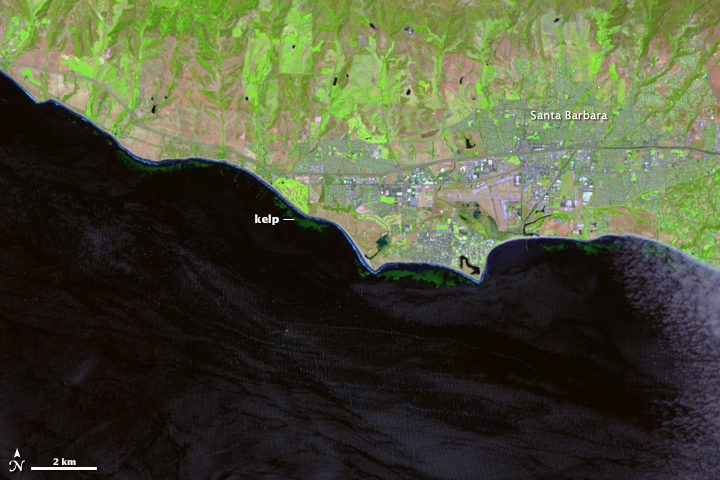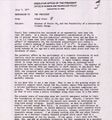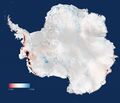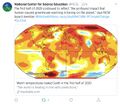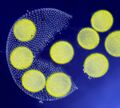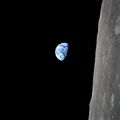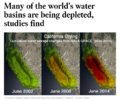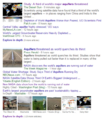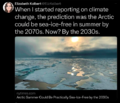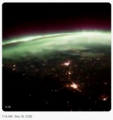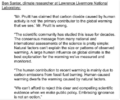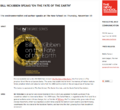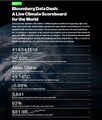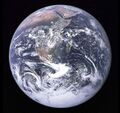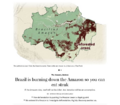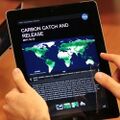Category:Planet Citizens, Planet Scientists
|
|
Continuing GreenPolicy360's "Planet Citizen, Planet Scientist" efforts
Take a look at the newly launched Floating Forest Project -- and a request for help from planet citizens who are willing to volunteer as planet scientists.
The Floating Forest website has been using satellite imaging to identify ocean 'forests' but acknowledge that... "Automated classification methods just don’t produce acceptable levels of accuracy...”
Citizen scientists are now being recruited via the Internet. Volunteers are given instruction in how to hunt for giant kelp in satellite imagery.
As a planet volunteer you will be given Landsat images and asked to outline any giant kelp patches you find.
Your findings will be crosschecked with those from other citizen scientists and then passed to the Floating Forest science team for verification.
The size and location of these forests are catalogued and used to study global kelp trends.
As of January 11, 2015, more than 3,400 citizen scientists had joined up to look for kelp in 328,000 Landsat images...
○
GreenPolicy believes this is a planetary moment to jump in, sign up, help out -- be a planet citizen, planet scientist!
Floating Forests - Earth Observatory/NASA-Landsat
Origin of Floating Forests Project
○ ○ ○ ○ ○ ○ ○ ○ ○ ○ ○ ○ ○ ○ ○ ○
Landsat 8 detects near-infrared wavelengths of light to spot & monitor offshore kelp forests (NASA Earth Observatory image)
○ ○ ○ ○
○ ○ ○ ○
"Kelp are the redwoods of the sea..." The world’s largest marine plants, they regularly grow up to 35 meters (115 feet) tall.
- Floating Forests
Help with the Kelp, Join in -- be a Be a Planet Citizen, Planet Scientist -- http://www.floatingforests.org/
Floating Forests - Earth Observatory/NASA-Landsat
Origin of Floating Forests Project
Planet Citizen, Planet Scientist
Kyle Cavanaugh had an idea. “These forests change so rapidly and on a variety of different time scales—months to years to decades—so we needed a long record with consistent, repeated observations,” Cavanaugh said. He devised a method to use Landsat satellite data to monitor kelp forests.
A few things made Landsat an obvious resource. Since the 1970s, the satellites have had a regular collection schedule (twice monthly). Their data and images are managed by the U.S. Geological Survey and are reliably stored in an archive that dates back more than forty years. And Landsat’s images are calibrated, or standardized, across different generations of satellites, making it possible to compare data collected across several decades...
Landsat measures the energy reflected and emitted from Earth at many different wavelengths. By knowing how features on Earth reflect or absorb energy at certain wavelengths, scientists can map and measure changes to the surface. The most important feature for the kelp researchers is Landsat’s near-infrared band, which measures wavelengths of light that are just outside our visual range. Healthy vegetation strongly reflects near-infrared energy, so this band is often used in plant studies. Also, water absorbs a lot of near-infrared energy and reflects little, making the band particularly good for mapping boundaries between land and water.
“The near-infrared is key for identifying kelp from surrounding water,” Cavanaugh explained. “Like other types of photosynthesizing vegetation, giant kelp have high reflectance in the near infrared. This makes the kelp canopy really stand out from the surrounding water.”
○
After a recent meeting on kelp forests and climate change, researchers Byrnes, Cavanaugh, and other colleagues set out to consolidate all of the available kelp forest data from around the world. They wanted to take a step toward understanding how climate change is affecting kelp globally, but they quickly discovered they had a sparse patchwork of information.
Byrnes was struck with a thought. They had used Landsat to expand their studies across time, so why not use Landsat to expand their studies around the world? Could Landsat be used to establish global trends in kelp forest extent? The answer was yes, but the problem was eyeballs.
Unlike research on terrestrial vegetation—which uses Landsat data and powerful computer processing arrays to make worldwide calculations—distinguishing kelp forests requires manual interpretation. While kelp forests pop out to the human eye in near-infrared imagery, computers looking at the data numerically can confuse kelp patches with land vegetation. Programs and coded logic that separate aquatic vegetation from land vegetation can be confounded by things like clouds, sunglint, and sea foam...
"Automated classification methods just don’t produce acceptable levels of accuracy..."
Byrnes and Cavanaugh put together a science team and joined with Zooniverse, a group that connects professional scientists with citizen scientists in order to help analyze large amounts of data. The result was the Floating Forests project.
https://www.zooniverse.org/#climate
https://www.zooniverse.org/#nature
The Floating Forest concept is all about getting more eyeballs on Landsat imagery. Citizen scientists—recruited via the Internet—are instructed in how to hunt for giant kelp in satellite imagery. They are then given Landsat images and asked to outline any giant kelp patches that they find. Their findings are crosschecked with those from other citizen scientists and then passed to the science team for verification. The size and location of these forests are catalogued and used to study global kelp trends.
Join in!
○ ○ ○ ○
Planet API | #PlanetAPI | Planet Citizen | #PlanetCitizen
GreenPolicy360 | #Earth360 | #EarthImaging | #EarthMonitoring
GP360 | #EarthObservations | #EarthScience | #NewSpace
#EarthPOV | Earth Point of View
○ ○ ○ ○
Subcategories
This category has the following 70 subcategories, out of 70 total.
A
B
C
D
E
F
G
H
M
N
O
P
R
S
T
W
Pages in category "Planet Citizens, Planet Scientists"
The following 200 pages are in this category, out of 226 total.
(previous page) (next page)A
B
C
- California is ahead of the game as Obama releases Clean Power Plan
- California out in front in a Green future
- Carbon Brief
- Citizen Science
- Climate Change - Global Warming Keyword-Terms
- Climate Change Denier Talking Points -- and Rebuttals
- Climate Change Summit Paris
- Climate Desk
- Climate migration
- Climate News
- Climate News Events Archive ... 1970 to Today
- Climate Plans Enforcement - Resources
- Climate Problems, Climate Solutions
- Climate Resilience Toolkit-USA.GOV-NOAA-NASA
- Conflict Resolution
- Copernicus EU
- Creatively Green
D
E
- Each of us can make a positive difference
- Earth
- Earth and Space, Politics
- Earth Day
- Earth Day 2020
- Earth Day Is Every Day
- Earth Day Memories on the 50th Anniversary
- Earth Day Summit - April 22 2021
- Earth from NASA
- Earth Imaging-New Space
- Earth Right Now
- Earth Science
- Earth Science Eco-Fields
- Earth Science Research from Space
- Earth Science Vital Signs
- EarthPOV
- Earthrise
- EarthTime
- EBikes 360
- Eco-nomics
- Ecolivia
- Ecotourism
- Energy Storage - Batteries and Grid
- Environmental agreements
- Environmental full-cost accounting
- Environmental Law, Rollbacks under Trump 2016-20
- Environmental Laws and Modern Environmental Movement
- Environmental movement
- Environmental protection
- Environmental Protection Agency
- Environmental Studies Online
- EOS eco Operating System
- ESA Living Planet Announcement - May 2022
- European Union Green Deal - Fit for 55
- EV Corridors Electric Vehicles Zero Emission Vehicles
- Extinction
F
G
- Generation Green
- Geoengineering
- George E. Brown Jr
- Glasgow Climate Summit - Pledges, Promises, Declarations - What's Next Up
- Global Citizen
- Global Climate Action Summit
- Global Fishing Watch
- Global Forest Watch
- Global Risks Report
- GN-z11
- Going Green
- Going Green: Texas v. Pennsylvania
- Google Earth
- Google Earth Timelapse
- GP360 NewPages
- Green AI
- Green Bank in Maryland - and More
- Green Best Practices
- Green Education
- Green Marketing
- Green New Deal
- Green Party
- Green Politics 360
- Green Politics with GreenPolicy360
- Green Quotes
- Green Stories of the Day
- Green Stories of the Day - GreenPolicy360 Archive
- GreenAction
- Greening Our Blue Planet
- GreenLinks
- GreenPolicy360 (eOS)
- GreenPolicy360 Archive Highlights 2013
- GreenPolicy360 Archive Highlights 2014
- GreenPolicy360 Archive Highlights 2015
- GreenPolicy360 Archive Highlights 2016
- GreenPolicy360 Archive Highlights 2017
- GreenPolicy360 Archive Highlights 2018
- GreenPolicy360 Archive Highlights 2019
- GreenPolicy360 Archive Highlights 2020
- GreenPolicy360 Archive Highlights 2021
- GreenPolicy360 Archive Highlights 2022
- GreenPolicy360 Archive Highlights 2023
- GreenPolicy360 Highlights
- GreenPolicy: Science
- GTN GreenLinks Trending News
I
L
M
N
P
- Paris climate change conference, Dec12, 2015 report from Rebecca Solnit
- Permaculture Green Practices
- Permafrost
- Planet API
- Planet Citizen Action
- Planet Citizen Vision of Living Earth
- Planet Citizens
- Planet Citizens, Planet Scientists
- Planet Earth Perspective
- Planet Labs Doves Fly
- Planet of the Humans, a documentary film
- Planetary.org
- PlanetCitizen
- Pledge for Planetary Health via The Lancet
- Privacy on the Net-Online Rights
- ProjectDrawdownCO2
R
S
- Sea-Level Rise
- Sea-Level Rise Environmental Research Letters
- Seagrass
- Siterunner
- Solar Power for Electric Vehicles
- Solar Power Plants in the Mojave Desert
- Stardust Origins
- Stats - Green Research & Science
- Steven Schmidt
- Strategic Policy-Internet Online Rights
- Student Climate Strike-March 15, 2019
- Sustainability
Media in category "Planet Citizens, Planet Scientists"
The following 200 files are in this category, out of 1,568 total.
(previous page) (next page)- 'Thin Blue Layer' of Earth's Atmosphere 2.jpg 800 × 486; 46 KB
- 'Thin Blue Layer' of Earth's Atmosphere l.jpg 853 × 486; 46 KB
- 'Thin Blue Layer' of Earth's Atmosphere m.jpg 426 × 240; 15 KB
- -HelloEarth.png 579 × 381; 0 bytes
- 03-Scott-Kelly-NASA.jpg 800 × 500; 113 KB
- 1.2-million-galaxies-cross-section-e1468508533423.png 800 × 372; 435 KB
- 1.2-million-galaxies-map-slice.jpg 800 × 600; 326 KB
- 10G internet on the way - Oct 2020.jpg 522 × 511; 145 KB
- 1977 from the Office of Science and Technology Policy.jpg 661 × 711; 177 KB
- 2001 pic3.jpeg 800 × 450; 65 KB
- 2015 temp-report s.jpg 399 × 224; 35 KB
- 2020 record temperatures.png 800 × 502; 358 KB
- 29 Days on the Edge w James Webb.png 527 × 461; 215 KB
- 3-15-2016 12-29-07 PM.png 538 × 701; 201 KB
- 33 false statements.png 640 × 91; 19 KB
- 3M lawsuit re forever chemicals - June 2023.png 603 × 600; 357 KB
- 43245326 2662602463753498 4405976459546460160 o.jpg 1,598 × 1,200; 163 KB
- 5 19 14 andrew antarcticaelevationchanges-640x547.jpg 640 × 547; 59 KB
- 7-20-2020 GreenPolicy360 RT No.2.jpg 591 × 510; 125 KB
- A Brief History of the Future - 2s.jpg 448 × 309; 70 KB
- A Fierce Green Fire.jpg 208 × 314; 13 KB
- A Flash of Green by John D. MacDonald.jpg 400 × 400; 55 KB
- A Planet Citizen View.png 799 × 1,241; 1.64 MB
- A root and its mycorrhizal fungus surroundings.PNG 315 × 382; 236 KB
- A scorching year, what about the 360 warming data.jpg 600 × 706; 106 KB
- A View of the Earth and Moon from Mars.jpg 720 × 890; 3 KB
- About Baselines and Change.png 592 × 312; 33 KB
- About website of The Invading Sea.png 800 × 343; 126 KB
- Above.png 500 × 375; 173 KB
- Acceptance on behalf of the United States of America.png 448 × 306; 62 KB
- Act now for a livable future.png 501 × 275; 272 KB
- Acting on Climate Change.png 402 × 139; 109 KB
- Acting to make a positive difference - in St Petersburg Florida.png 600 × 723; 645 KB
- Actually watching the planet breathe.png 800 × 446; 649 KB
- Ag production and GHG emissions.jpg 680 × 510; 33 KB
- Against the Tide - Cover - by Cornelia Dean.jpg 308 × 475; 57 KB
- Air Pollution Kills, Injures, Cripples, Disables.jpg 600 × 697; 153 KB
- Alaska Willow - March 12 2023.png 576 × 230; 99 KB
- Alaska Willow News-March 12 2023.png 576 × 625; 235 KB
- Aldis zone blog.jpg 500 × 498; 67 KB
- Algae release -nikon-small-world-competition-2017-winners.jpg 640 × 576; 89 KB
- All species day with homo sapien in Santa Fe .jpg 640 × 369; 98 KB
- Amazon fires burn across the rainforest.jpg 800 × 504; 76 KB
- Amazon, the violent destruction - Aug 2022.png 640 × 285; 199 KB
- Amazon-rainforest.jpg 814 × 459; 142 KB
- American Jobs Act compared w THRIVE Act (Green New Deal).jpg 674 × 798; 90 KB
- Andrew Wheeler confirmed to head EPA.jpg 753 × 600; 85 KB
- Antarctic sea ice 1989-2023 chart as of July2023.png 640 × 433; 294 KB
- Antarctica-2018.jpg 768 × 1,024; 82 KB
- Anthro-transport via globaia.org.jpg 800 × 450; 444 KB
- Anthropocene bks016.png 800 × 248; 227 KB
- Anthropocene Economist.png 775 × 349; 369 KB
- Anthropocene-550x360.png 550 × 360; 335 KB
- Anthropocene-crutzen.jpg 628 × 347; 79 KB
- Anthropocene-economist cover.jpg 750 × 320; 223 KB
- Anthropocene-nature March2015.jpg 747 × 407; 103 KB
- Anthropocene-the-geology-of-humanity.jpg 628 × 347; 79 KB
- Anthropocene.jpg 450 × 187; 18 KB
- Anti science, anti open data - EPA April 2017.png 429 × 616; 198 KB
- AOC March 26, 2019.jpg 597 × 433; 58 KB
- AOC re climate task force - july 8 2020.jpg 585 × 203; 38 KB
- Apollo 11 - 21 July 1969.jpg 750 × 395; 45 KB
- Apollo 8, Life Jan10,1969.png 480 × 635; 515 KB
- Apollo programme for clean energy .png 617 × 357; 85 KB
- Apollo.jpg 715 × 715; 102 KB
- April 28, 2016.png 586 × 415; 159 KB
- Aquifers earthsciencefromspace Grace CA3.png 772 × 652; 559 KB
- Aquifers global earth observations by grace20150616-16 m.jpg 800 × 450; 117 KB
- Aquifers global earth observations by grace20150616-16.jpg 1,600 × 900; 317 KB
- Aquifers globalstudy 2015.png 668 × 451; 299 KB
- Aquifers June2015 past the tipping point.png 533 × 615; 195 KB
- Aramco profits soar - 2022.png 636 × 684; 373 KB
- Arctic - Kolbert - 2023.png 553 × 476; 274 KB
- Arctic 30.1 C at 62.5 N.jpg 800 × 432; 80 KB
- Arctic annual average temp 1981-2010.jpg 800 × 534; 76 KB
- Arctic heat in Russia-Siberia 2020.gif 784 × 408; 3.6 MB
- Arctic Melt - 1950-2020.png 640 × 349; 287 KB
- Arctic sea ice watch 25 yrs of ice cover change.png 697 × 386; 314 KB
- Arctic Siberia Heatwave - Again - June 2021.jpg 640 × 360; 83 KB
- Arctic-100 yrs difference.jpg 640 × 883; 59 KB
- Arctic-March30,2019.jpg 797 × 600; 126 KB
- Arctic-Siberia-6-20-2020.jpg 478 × 644; 148 KB
- As Earth Warms, NASA Targets 'Other Half' of Carbon, Climate Equation.jpg 1,504 × 846; 242 KB
- AskNatureAvatar s.png 200 × 200; 14 KB
- Asteroid Watch JPL.jpg 779 × 312; 113 KB
- Astro POV - Mike Massimino - PlanetCitizen.png 800 × 466; 792 KB
- Astro Samantha.png 448 × 266; 78 KB
- Astronaut Photography of Earth ISS Cupola 2014.png 799 × 314; 325 KB
- Astronaut-chris-hadfield-earth-photo.jpg 960 × 638; 105 KB
- At Independence Hall - Sept 1, 2022.png 400 × 638; 416 KB
- Atmosphere Science.jpg 800 × 600; 45 KB
- Atmospheric Experiment of Humanity.jpg 519 × 574; 201 KB
- Attack from Within - by Barb McQuade.png 600 × 630; 222 KB
- AU Too Hot.png 640 × 413; 286 KB
- Audubon - Photo by Shari McCollough.jpg 795 × 559; 76 KB
- Audubon study ms.png 529 × 434; 437 KB
- Aurora from the ISS 2016.png 844 × 434; 150 KB
- Aurora Green 2022.png 600 × 638; 330 KB
- Aurora Time.png 829 × 780; 544 KB
- Backbone of Night - The Milky Way by Andrew McCarthy 2023.png 796 × 1,722; 2.3 MB
- Bamboo-400x400.jpg 400 × 112; 27 KB
- Bamboo-800x150.jpg 800 × 150; 34 KB
- Banking - finance - climate - Mann-1.jpg 452 × 640; 162 KB
- Banking - finance - climate - Mann-2.jpg 452 × 640; 164 KB
- BantheBag California-OutinFront.png 519 × 715; 449 KB
- Barrier island hubris 6-29-2021.jpg 490 × 635; 111 KB
- Battle for Democracy.jpg 640 × 123; 24 KB
- Be a citizen scientist iNaturalist.png 645 × 354; 217 KB
- Be a planet citizen, make a choice, act to reduce climate change.jpg 1,024 × 595; 60 KB
- Be Worried, Be Very Worried.jpg 400 × 533; 211 KB
- Beginning of WWW 89 TimBerners-Lee CERN.jpg 522 × 753; 46 KB
- Ben Santer to Pruitt March 2017.png 506 × 420; 0 bytes
- Bernie Sanders, Senate 2.PNG 800 × 517; 379 KB
- Bernie Sanders, Senate Aug 3.PNG 800 × 518; 388 KB
- Best Practices check sm.png 60 × 60; 0 bytes
- Biden - clean energy ambitions.JPG 640 × 334; 31 KB
- Biden announces EV policies - Aug 2021.jpg 600 × 604; 112 KB
- Biden introduces leadership team - Nov 24 2020.jpg 800 × 644; 173 KB
- Biden re Earth Day 2023.png 640 × 400; 155 KB
- Biden selects Kerry as special climate envoy.jpg 592 × 505; 87 KB
- Biden urged to act - Oct 18 2021 - The Guardian.png 663 × 600; 497 KB
- Biden's assembled an all-star climate team 4-21-2021.jpg 682 × 732; 309 KB
- Biden-Harris, CNN News Online - Nov 8, 2020.jpg 800 × 484; 114 KB
- Biden-January 27 2021-Environment Day 1-News headlines.jpg 800 × 673; 122 KB
- Biden-January 27 2021-Environment Day 1.jpg 800 × 500; 80 KB
- Biden-Sanders Unity Task Force on Climate.jpg 701 × 780; 139 KB
- Big Oil Rocked by News May 27 2021.jpg 639 × 600; 84 KB
- Big Wobble 2020.jpg 507 × 342; 79 KB
- Biggest climate related legislation in history - 1.png 800 × 188; 68 KB
- Bill McKibben switches gears-Sept 2021.jpg 518 × 265; 78 KB
- Bill McKibben to next generations.JPG 700 × 700; 203 KB
- Bill McKibben-Fate of the Earth Inaug-New School.png 800 × 735; 303 KB
- Bill Nelson on Global Temp Rise and Climate Change.png 640 × 353; 100 KB
- Bill Nye explains.jpg 543 × 508; 88 KB
- Bill Nye The Planet's on Fire.jpg 800 × 675; 106 KB
- Bill nye-march for science-earth day.jpg 800 × 533; 115 KB
- Biodiversity COP15 Conference - Dec 2022.png 640 × 417; 637 KB
- Biodiversity COP15 News - 1.png 600 × 687; 288 KB
- Biodiversity COP15 News - 2.png 600 × 636; 340 KB
- Biodiversity-by-dreamchaotic.jpg 600 × 173; 66 KB
- Biomega-OKO 2.jpg 473 × 360; 34 KB
- Bioneers - LDF-One Earth Plan.png 800 × 716; 781 KB
- Bioneers 2023 - ThirdAct.Org.jpg 624 × 600; 145 KB
- Bioneers Conf 2021- Buckminster Fuller Instit joins.png 469 × 586; 599 KB
- Bioneers conference 2018-o.jpg 800 × 400; 134 KB
- Bioneers conference 2019 - 30 years anniv.jpg 800 × 400; 129 KB
- Bioneers It's all connected - 30th annual conference.jpg 527 × 521; 79 KB
- Bloomberg Carbon Clock 10-26-2021 8-47-05 AM EST.png 800 × 195; 356 KB
- Bloomberg Live Climate Data Dashboard.jpg 640 × 756; 156 KB
- Blue Marble memories in 2022.png 768 × 969; 727 KB
- Blue Marble photo - Apollo 17.jpg 642 × 605; 129 KB
- Blue Marble photo taken by the crew of Apollo 17 (1972).jpg 642 × 605; 129 KB
- Blue-Green & Planet Citizens, Planet Scientists.png 549 × 844; 94 KB
- BMW wireless-charging.gif 640 × 356; 3.19 MB
- Bmw-i3.JPG 800 × 460; 108 KB
- BMW-Solar Charging Point.jpg 537 × 357; 54 KB
- Boom, SUNRISE.jpg 1,024 × 682; 24 KB
- Brazil Amazon deforestation - circa 2022.png 688 × 600; 397 KB
- Brazil INDC 2015.png 592 × 366; 301 KB
- Breakpoint - Reckoning with America's Environmental Crisis.jpg 329 × 500; 49 KB
- Bridenstine talks.png 1,485 × 911; 223 KB
- Brief History of Carbon Emissions as of 2016.png 770 × 425; 342 KB
- Brightest-galaxy.jpg 900 × 585; 206 KB
- Buckminster and a Geodesic Dome.jpg 600 × 600; 79 KB
- Bucky Trimtab.jpg 348 × 336; 88 KB
- Bug eyes in the rainforest canopy Photo by Don Perry-2.jpg 300 × 576; 24 KB
- Burning the Data.png 640 × 597; 434 KB
- Burst of climate denial as Trump presidency ends.jpg 632 × 604; 92 KB
- C02 in atmosphere chart-3.png 570 × 800; 133 KB
- C40 Cities actions.jpg 1,023 × 696; 174 KB
- CAIT Map 1.png 800 × 415; 123 KB
- California at the forefront of US environmental policies.png 600 × 450; 50 KB
- California Pipevine Swallowtail Project butterflies.png 327 × 185; 132 KB
- California's kelp forests and coastal biodiversity diminished.png 532 × 754; 307 KB
- Canary - 1.jpg 448 × 901; 144 KB
- Canary - 2.png 446 × 531; 264 KB
- Car heating and cooling.png 465 × 635; 261 KB
- Carbon Brief - Greenhouse gas levels 2021.png 640 × 436; 292 KB
- Carbon catch and release m.jpg 250 × 250; 15 KB
- Carbon Footprint - BP-McKibben-Solnit-Aug2021.jpg 516 × 264; 66 KB
- Carbon Mapper - Launch - April 2021.jpg 800 × 323; 92 KB
- Carbon-footprint small or large.jpg 149 × 258; 0 bytes
- Carbon-footprint.jpg 297 × 516; 59 KB
- Cardinal directions m.png 250 × 250; 20 KB
- Caribbean Sea hot - June night 2024.png 676 × 600; 386 KB
- Carl Sagan at the Emerging Issues Forum - 1990.png 360 × 460; 192 KB
- Carl Sagan at the Emerging Issues Forum.png 747 × 600; 600 KB
- Carl Sagan, 1985.PNG 480 × 566; 331 KB
- Carl Sagan, the atmosphere unifies and connects all of our world.png 360 × 390; 229 KB
- Caroline Lucas-Green New Deal.jpg 584 × 391; 71 KB
- Casey Camp-Horinek.jpg 606 × 650; 132 KB
